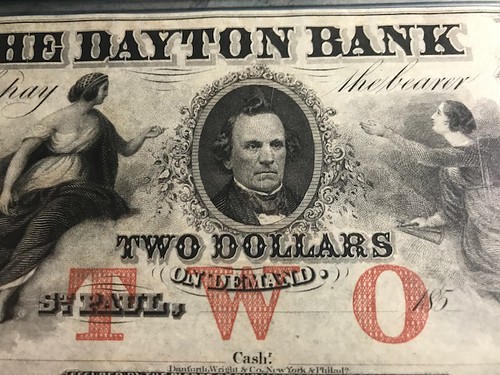
PREV ARTICLE
NEXT ARTICLE
FULL ISSUE
PREV FULL ISSUE
QUERY: BANKNOTE PROTECTOR PRINTING  Wendell Wolka of Sun City Center, FL writes: Another head scratcher....many obsolete bank notes employ protectors as a counterfeit and alteration deterrent. Typically this is printed in color (red, green, blue, etc.) and appears as the denomination spelled out in large letters (ONE, FIVE, etc) across the face of the note. Often the protector image also appears on the the back also perfectly printed (not "soaked through") but as a mirror image as if it HAD somehow transferred through the paper. Two questions...any idea HOW this was printed and number two WHY this was done? Hmmm... No clue here. I reached out to researcher Mark Tomasko of New York City; his observations follow. Thanks! -Editor
The explanation I have seen of the printing does not explain the process very well. Dave Bowers on page 334 of his 2006 Obsolete Paper Money volume points to the explanation in the 1864 Heath's Infallible Counterfeit Detector, which provides an example of the process as Plate 8. Heath's explanation is as follows (he's referring to the color printing of, say, FIVE or some other denomination on both sides of a bank note): 'The way in which the denomination is printed on both sides of a genuine note is this: In the first place, the die is covered with ink, and an impression is taken from that on a piece of thick paper; the note is then laid on that paper face up and the die stamped on the face; so that the back of the note takes the impression from the thick paper, and both sides being printed from the same die, one side will correspond with the other.' As someone who prints intaglio, this explanation is a little hard to envision in practice. And it does not seem to explain the perfect registration, face to back, but if the piece of thick paper is exactly the size of the tint plate, maybe that's part of the answer. Perhaps others know of better explanations. In any case I believe the purpose of the two sided printing is the perfect registration "see-through" effect, which would be difficult to duplicate. Interestingly, this "see-through" concept is very much used on current international bank notes, nicknamed "c-thru" by the modern era bank note designers. Wayne Homren, Editor The Numismatic Bibliomania Society is a non-profit organization promoting numismatic literature. See our web site at coinbooks.org. To submit items for publication in The E-Sylum, write to the Editor at this address: whomren@gmail.com To subscribe go to: https://my.binhost.com/lists/listinfo/esylum All Rights Reserved. NBS Home Page Contact the NBS webmaster 
|